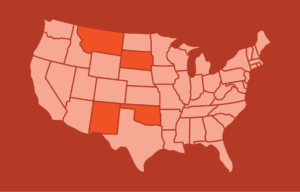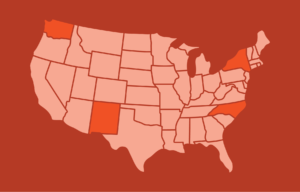The Road to Reproductive Justice: Native Americans in New Mexico
Introduction
Indigenous communities have long been leading the fight to ensure the fundamental human rights of Indigenous/Native American women and families. As leaders in reproductive justice and environmental justice, Indigenous communities have built community networks to address gaps in access to care, systemic violence and oppression at the hands of state and federal governments, and erasure of their communities.1
For all families to thrive, we know that Indigenous communities must be at the center of building people power, building movements, and engaging in cultural strategies. Yet, across the country, Native Americans are often labeled as “not statistically significant” in research because they are a small percentage of the overall U.S. population. Many times Indigenous communities are erased from advocacy and policy efforts. Instead, racism and stereotypes fuel how the national dominant narrative depicts Native Americans and fuel how their fundamental human right to healthcare is further disregarded or denied. As communities directly experiencing centuries of reproductive oppression, the needs and perspective of Native communities must be part of the broader reproductive health and rights movement that is guided by the experiences of BIPOC (Black, Indigenous and people of color) communities.
Why New Mexico and Why This Research
The past three years have seen unprecedented attacks around reproductive rights at the federal, state and local levels. The Trump administration came into office with an aggressive agenda to roll back access to reproductive healthcare. While the majority of federal-level policy changes were stopped, the administration continues a strategy of rule changes that limit and constrict access.
But the main theater for attacks on reproductive health and rights has been at the state level. In 2019, we saw a new wave of abortion bans across the states in the Midwest and South. By the end of that year, 25 new abortion bans had become state laws.2
2019 was also the year the New Mexico State Senate failed to pass a bill on the floor that would have removed a harmful abortion ban from state statute. During the course of the debate about the bill, legislators often spoke for Native communities, claiming that Native Americans are against abortion due to cultural and religious beliefs.
From our work with Native American communities in New Mexico, Forward Together knows these stereotypes simply aren’t true. We know that the voices and experiences of Native communities are missing from state-level conversations about reproductive health. These experiences are ignored and omitted — or worse yet spoken for — even while Native communities speak for themselves on these topics.
To our knowledge, our original research exploring the opinions of Native Americans around reproductive health is the first of its kind. We found these key data.
- 89% of surveyed Native Americans believe that Native American women and families deserve to make their own healthcare decisions without government interference.
- 72% of surveyed Native Americans agreed with the statement: “I can hold my own moral views about abortion and still trust a woman and her family to make this decision for themselves.”
- 1 in 3 surveyed Native Americans knew that the federal Hyde Amendment explicitly prohibits the use of federal funds to provide abortion care at Indian Health Service (IHS) clinics.
In order to change the narrative, the 2020 research conducted by Southwest Women’s Law Center, Latino Decisions, and Forward Together focused on the experiences of reproductive healthcare and the views and beliefs of Native Americans in New Mexico. Our findings reveal that Native Americans, rural and urban, hold respectful and complex views and values on abortion care. In addition, our original research surfaces the unique experiences of Native communities around reproductive health and shows the places where policy and service delivery must shift in order to improve health outcomes for all Native people.
Native Americans in New Mexico
There are 23 tribes in New Mexico comprised of 19 pueblos, Navajo Nation, Jicarilla Apache Nation, Mescalero Apache Tribe, and Fort Sill Apache Tribe. The majority of survey respondents belonged to these tribes, plus some other tribal affiliations as well.
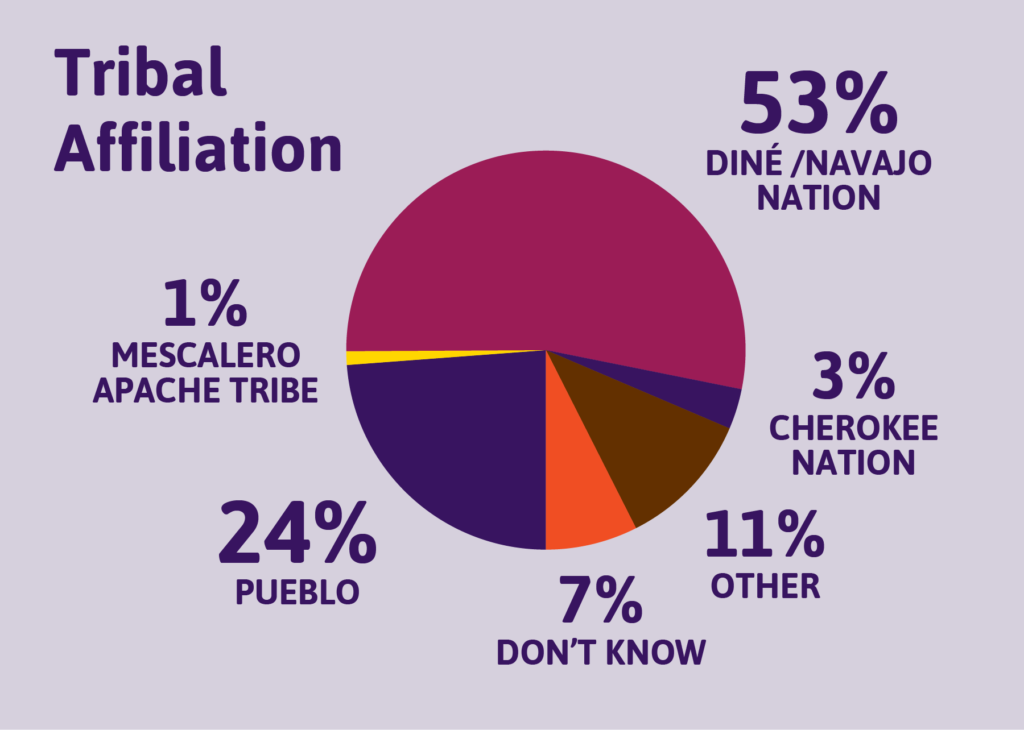
Respondents also included a good mix of Native Americans who live both on the reservation or tribal lands (49%), off tribal lands (37%), and those who split their time between the two lands (14%). Respondents included a majority who identify as male or female, with only 2% identifying as transgender. Those interviewed included adults from 18 years to over 65 years in age, and a mix of political party affiliations.
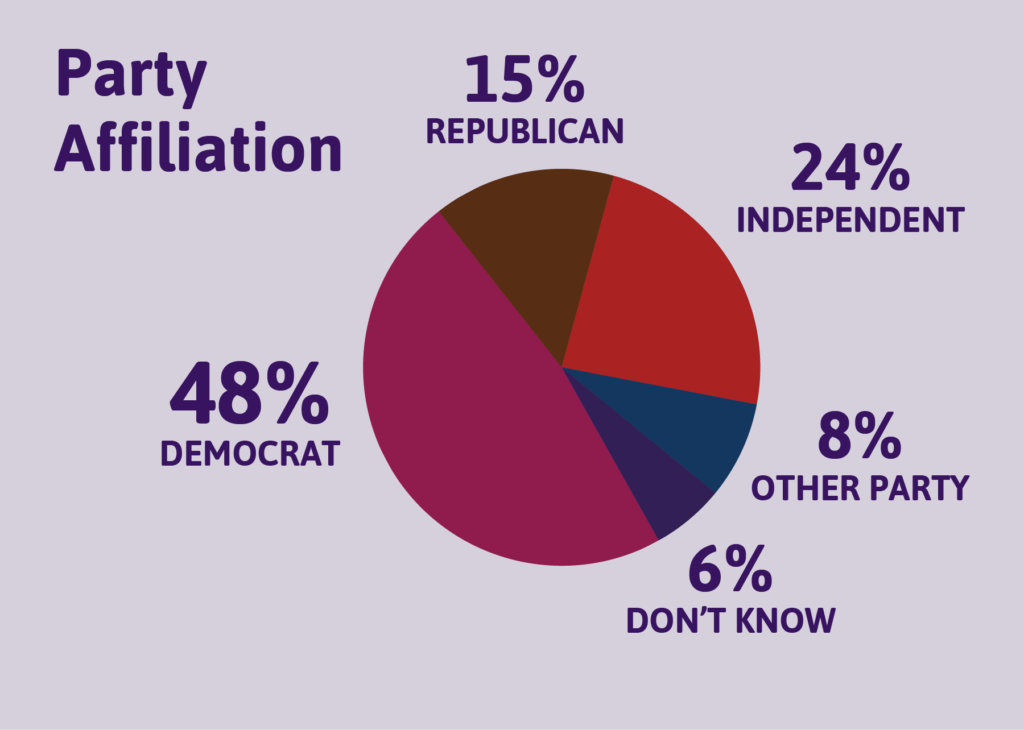
While this research is specific to Native American communities in New Mexico, it is also relevant for the rest of the country, where tens or hundreds of thousands of Indigenous peoples live in nearly every state.3 States with similar population sizes of Native Americans include Washington, New York and North Carolina. States with a proportion of Native Americans compared to the overall population that are similar to New Mexico include Montana, South Dakota and Oklahoma.
Research Relevance: States with Similarities to New Mexico
Native Americans Opinions Around Reproductive Health
Decision Making in Reproductive Health
Our research found that a vast majority of Native American respondents (89%) believe that Native American women and families deserve to make their own healthcare decisions without government interference. 72% also agreed with the statement: “I can hold my own moral views about abortion and still trust a woman and her family to make this decision for themselves.”
Access to Comprehensive Reproductive Healthcare
The top two barriers identified by Native survey respondents to accessing reproductive healthcare are transportation (27%) and cost of accessing reproductive healthcare services (17%). Financial barriers have real consequences; a national study found that 41% of Native American women cite cost as a barrier to receiving the recommended number of prenatal visits during pregnancy.4 In New Mexico, around 187,000 people are uninsured and the majority of those uninsured are in the lowest income brackets.5 1 in 5 people who are uninsured in our state are Native American, totaling about 37,000 New Mexicans who are uninsured.6
Over 1 in 5 respondents did not believe that Native Americans in their community have access to reproductive healthcare. Only 29% of Native Americans stated that there is a doctor’s office, hospital or other health clinic that provides abortion in the community where they normally get healthcare. What many survey respondents may not know is that only three communities in New Mexico have a clinic that provides abortion services.7
Challenges and Opportunities with Indian Health Service (IHS) Healthcare
Over 41% of those surveyed were receiving reproductive healthcare services through IHS or a Tribal 638 clinic, both federally funded healthcare services for Native Americans. IHS clinics provide healthcare to approximately 2.6 million Native Americans who belong to 573 federally recognized tribes in 37 states.8 Tribal 638 clinics are stand-alone healthcare providers set up by a federally recognized tribe. These clinics contract with IHS to provide services.
Given that over 75% of our survey respondents are enrolled members of a tribe, pueblo or nation and could receive health services from IHS or a Tribal 638 clinic, we asked why individuals chose not to receive their care through the existing system. Nearly one third of these respondents were uncomfortable receiving care at IHS clinics. Difficulty getting an appointment and the quality of care received were also among the top reasons that individuals chose not to get care at an IHS clinic. While many are satisfied with their care at IHS, others who do not believe they are getting all the resources and care they need seek care elsewhere.
The Hyde Amendment, which has prohibited federal funds from covering abortion for more than forty years, was codified by Indian Health Service in 1982. Because IHS is often the sole provider of health services for Native communities, the Hyde Amendment effectively denies Native American women access to the full scope of reproductive healthcare, which includes access to abortion. Our research found that 1 in 3 respondents (32%) were aware that the Hyde Amendment restricted access to abortion.
Personal Experience with Abortion
Native Americans in New Mexico also have personal experiences with abortion. Over 1 out of 3 respondents (35%) had a friend or family member who had an abortion. 1 out of 5 respondents (20%) had accessed abortion services in the past or had a partner who accessed abortion services in the past.
Regardless of the decision a person may make around pregnancy, Native Americans want their friends and family to experience support. Nearly 60% of respondents agreed with the statement: “If someone I care about has made the decision to have an abortion, I want them to have support.” For individuals who have been on this journey themselves, support for this statement skyrocketed: 71% of those who have had an abortion wanted someone they cared about to have support.
Health Disparities
Due to colonization, genocide, the underfunding of Indian Health Service, and many other factors, all health data show the severe disparities that Native Americans experience around health and wellness. Our original research surfaces a disparity that is rarely talked about: reproductive loss.
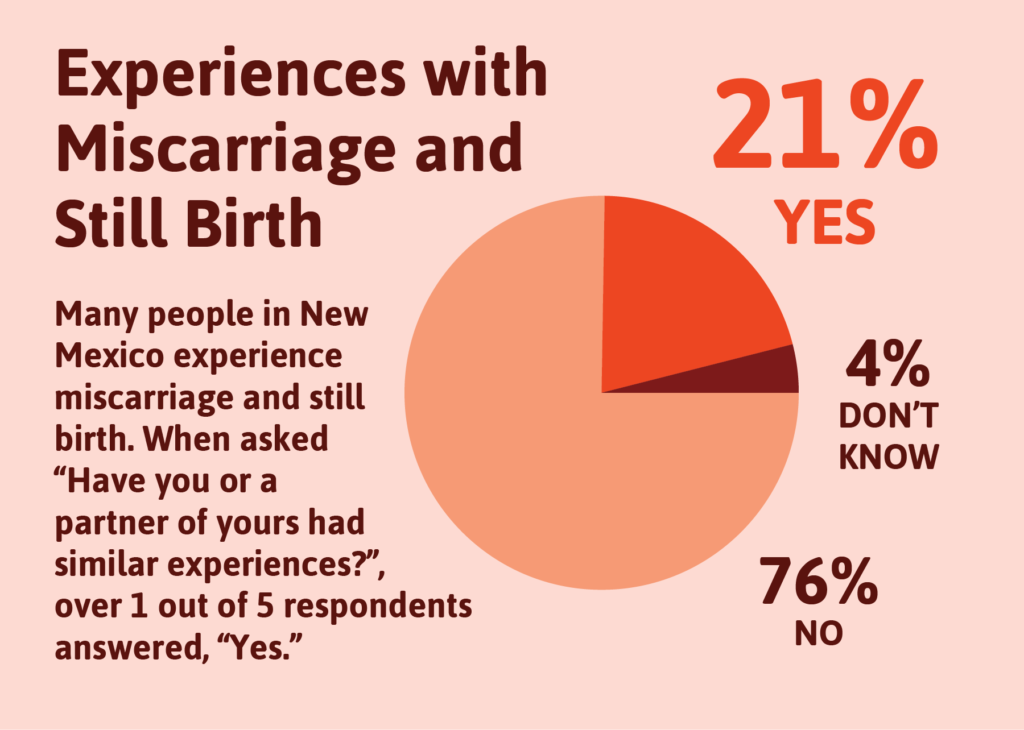
Our research showed that 1 in 5 Native Americans in New Mexico have experienced still birth or miscarriage, which is higher than the national average. More research focusing on the experiences of pregnant Native people interfacing with maternal healthcare provision is necessary in order to explore what needs to change. Far too often, interventions in healthcare are based on the experiences of healthcare providers and not on the experiences of community members.
Finally, our research also explored how Native Americans in New Mexico experience interpersonal violence. Nearly 2 out of 5 survey respondents (38%), had experienced domestic violence. Over 1 out of 5 respondents (22%) stated that they had experienced sexual assault or sexual violence in their life. Some national reports have shown that Native Americans are twice as likely to experience sexual assault compared to all other races.9
The Road Forward
Native Americans experience health disparities in many forms. Historical trauma and cycles of oppression that include stolen land, genocide, poverty, environmental contamination of lands, and more have impacted many generations. This research shows a portion of the effects through responses to questions about reproductive healthcare. To address the issues raised in the research, we need greater access to healthcare, as well as policy and community solutions, that can together improve the safety and wellbeing of Indigenous peoples for generations to come.
Indigenous communities have always been part of the reproductive justice movement. Indigenous women were part of committees that formed decades ago challenging forced sterilizations, and in the 1980s along with other racial and ethnic groups, started reproductive justice organizations. The reproductive health, rights and justice movement must include and center Indigenous voices, as well as those of Black communities and people of color. Many Native Americans believe in the reproductive justice values of self-determination and body sovereignty, respect in healthcare decision making, and reproductive healthcare access for all people. This polling uses data points to dispel myths and remind folks of what’s real.
Additional research that is community centered and reflects the healthcare realities and perspectives of Native Americans must be prioritized. Organizations interested in addressing the experiences of Indigenous people in New Mexico and beyond must start by centering Native people in their work.
Methodology and Acknowledgements
Survey development, research and data analysis were conducted in 2020 by Southwest Women’s Law Center, Latino Decisions, and Forward Together. Additional data analyses for this report were provided by Forward Together. Collaborating organizations on this project include Indigenous Life Ways and Tewa Women United.
Polling was conducted through phone and web-based interviews, resulting in 302 completed surveys. To our knowledge, this is the largest sample of Native Americans interviewed for the purposes of understanding experiences and attitudes toward reproductive health policy.
Road to Reproductive Justice: Native Americans in New Mexico builds on original opinion research conducted by Bold Futures, Latino Decisions, and Forward Together with rural New Mexican communities.
Endnotes
- The Native American Women’s Health Education Resource Center. (n.d.). SisterSong Native Women’s Reproductive Rights and Health roundtable convenes. Accessed on September 9, 2020, at https://www.nativeshop.org/news-110/93-information/698-2000-sistersong.html.
- Nash, E., Mohammed, L., Cappello, O., & Naide, S. (2019, December 10). State policy trends 2019: A wave of abortion bans, but some states are fighting back. Guttmacher Institute. Accessed on September 9, 2020, at https://www.guttmacher.org/article/2019/12/state-policy-trends-2019-wave-abortion-bans-some-states-are-fighting-back.
- USAFacts. (2019, November 21). Native Americans and the US Census: How the count has changed. Accessed on September 9, 2020, at https://usafacts.org/articles/native-americans-and-us-census-how-count-has-changed/.
- National Partnership for Women & Families. (2019, October). American Indian and Alaska Native Women’s Maternal Health: Addressing the Crisis. Accessed on September 9, 2020, at https://www.nationalpartnership.org/our-work/resources/health-care/maternity/american-indian-and-alaska.pdf.
- Banthin, J., Buettgens, M., Blumberg, L. J., Wang, R., & Pan, C. W. (2019, December 19). The uninsured in New Mexico, p. 4. Urban Institute. Accessed on September 9, 2020, at https://www.urban.org/research/publication/uninsured-new-mexico/view/full_report.
- Banthin, J., Buettgens, M., Blumberg, L. J., Wang, R., & Pan, C. W. (2019, December 19). The uninsured in New Mexico, p. 4. Urban Institute. Accessed on September 9, 2020, at https://www.urban.org/research/publication/uninsured-new-mexico/view/full_report.
- Dunlap, S. (2019, November 13). Access to abortion limited in NM. NM Political Report. Accessed on September 9, 2020, at https://nmpoliticalreport.com/2019/11/13/access-to-abortion-limited-in-nm/.
- U.S. Department of Health and Human Services, Indian Health Service. (2020, August). HIS profile. Accessed on September 9, 2020, at https://www.ihs.gov/newsroom/factsheets/ihsprofile/.
- RAINN. (n.d.). Victims of sexual violence: Statistics. Accessed on September 9, 2020, at https://www.rainn.org/statistics/victims-sexual-violence.
